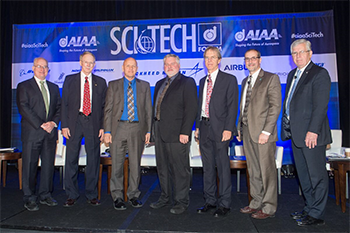Computer Prototyping Enhances Efficiency in Aircraft Design Written 9 January 2017
Panelists: Moderator Paul Nielsen, director and CEO, Software Engineering Institute, Carnegie Mellon University; Edward Kraft, technical adviser, Arnold Engineering Development Complex, Arnold Air Force Base; Robert Meakin, Air Vehicles project manager, Computational Research and Engineering Acquisition Tools and Environments, High Performance Computing Modernization Program, Department of Defense; Scott Morton, Kestrel principal software developer, CREATE Air Vehicles, DOD HPCMP; Robert Narducci, technical fellow, Boeing; Douglass Post, chief scientist, DOD HPCMP; Brian Smith, Lockheed Martin Fellow, Program and Technology Integration, Advanced Development Programs, Lockheed Martin Aeronautics
by Hannah Godofsky, AIAA Communications

The U.S. Department of Defense and private companies are using Computational Research and Engineering Acquisition Tools and Environments, or CREATE, to fix problems with innovative system designs before building prototypes. Members of the "CREATE: Enabling Innovation Through Computational Prototypes and Supercomputers" panel discussed the program and virtual system prototyping Jan. 9 at the 2017 AIAA SciTech Forum in Grapevine, Texas.
Bob Meakin, CREATE Air Vehicles project manager, said not only does virtual system prototyping allow engineers to verify their designs and fix flaws before key decision points and physical prototyping, but it also lets decision-makers assess planned operational use scenarios and system maintainability early in the acquisition process. Meakin said better planning as well as virtual wind tunnel rehearsals and flight tests lead to a more effective use of physical test budgets.
Scott Morton, Kestrel principal software developer with CREATE Air Vehicles, said the CREATE software is useful for virtual prototyping of everything from small drones to fighter jets. He showed examples of using CREATE to analyze propulsion integration, store separation, multibody static interference matrices and flight control system integration. Morton highlighted Kestrel's potential for doing robust simulations of whole integrated systems.
The panelists from Lockheed Martin and Boeing both discussed the importance of accurate, reliable results from simulation tools.
"We have to be convinced that the tool works and the results are reliable," said Brian Smith, a Lockheed Martin Fellow with Lockheed's Skunk Works.
He emphasized that validation and model implementation are critical to enable use of CREATE tools for industrial applications. Industry and government need to be able to obtain consistent results or understand the difference between simulations with different tools and methods, Smith said, explaining that Lockheed Martin used both Kestrel and Lockheed's in-house software tool, LM Aero Falcon, for F-35 Lightning II simulations.
Robert Narducci, a technical fellow at Boeing, echoed Smith's comments.
"We're on the hook for understanding what the tools are bringing and making sure the tools are accurate," he said.
Narducci said Boeing uses CREATE Air Vehicles' Helios for safety analysis but that Kestrel became attractive because it has capabilities outside the scope of Boeing's existing toolbox.
Ed Kraft, a technical adviser at the Arnold Engineering Development Complex, said virtual prototyping has been beneficial in integrating disparate systems into a complete aircraft.
"We can design the perfect aerodynamic performance vehicle; we can design the perfect I-beam; we can design the perfect isolated engine — but it's when you put them together that you have the discovery problems," he said. "I look at all the major subsystems as an integrated system, and that's a huge change."
